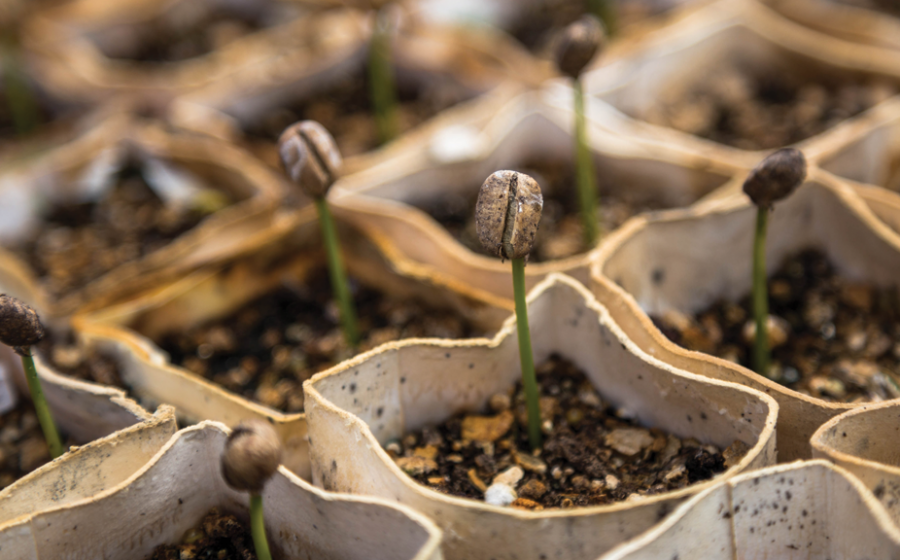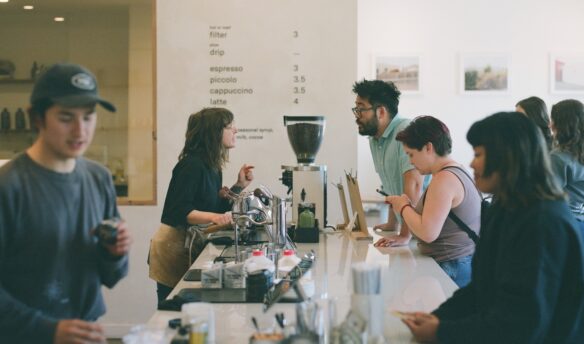[P]icture the verdant slopes of Latin America or the rolling hillsides of East Africa, where pickup trucks bounce along barely there roads en route to row upon row of coffee trees bearing red, ripening fruit.
Then picture your neighborhood roastery café, where the roastmaster carefully turns the green coffee into a consumable product, followed by a barista painstakingly crafting a delicious pour-over drink.
These two locales—where coffee begins as a plant and where it finishes as a drink—are about as disparate as two places can be, both in their geographical distance and in their look and feel. As such, it can boggle the mind to ponder how coffee gets from one setting to the other. While coffee’s seed-to-cup journey is indeed a long one, it’s a well-honed process full of logistics, paperwork, and maybe a little romance.
For a perspective seated in the center of the action, let’s view this journey from the perspective of the coffee importer, who serves as the middleman coordinating all links in the chain to enable coffee’s path to its destination. For our example seed-to-cup journey, let’s say that Local Roaster in Oakland, California, is using Bean Importer to purchase a coffee from Coffee Cooperative in Colombia’s Valle del Cauca Department.

Step 1: The Contract
While a coffee transaction ostensibly starts with the coffee on the tree—there would be no transaction without the raw product—it actually begins with a contract.
Local Roaster will tell Bean Importer it wants to purchase a container of coffee (about in Colombia, typically 250 154-pound bags) from Coffee Cooperative. The importer then sends a contract to the cooperative stipulating the expected delivery time of the coffee and providing shipping instructions to the preferred port of Local Roaster. The contract should also stipulate price. Typically the arrangements for contracted coffee will happen several months before shipment: since coffee from Valle del Cauca will be ready to ship around May, this contract may be finalized around January.
Another important element of that contract will be the quality stipulation, with Local Roaster asking for coffee hitting a certain quality target tied to the Specialty Coffee Association’s 100-point scale—for example, a minimum of 84. Contract quality specs can also include screen size, altitude (strictly hard bean [SHB], high grown [HG]), and defect count. For micro-lots, the contract specifies a coffee’s assigned lot name and unique identifying number.
Step 2: Securing the Coffee
With the contract in place, Coffee Cooperative will then go about gathering enough coffee to fulfill the order. In Colombia, wet milling and washing happen at an individual level rather than at communal cherry-collecting stations. Farmers will return from harvesting, process their cherries, and bring the coffee in parchment—the protective covering that helps preserve the bean—to Coffee Cooperative’s purchase point. The co-op will keep track of how much parchment it has amassed from its members, and will cup samples of each coffee to assess its quality. Knowing that it has a container’s worth of 84-point-minimum coffee to fill, the co-op will set aside coffee of this quality to build the lot.
Once Coffee Cooperative has amassed enough coffee to meet the contract, it will send a sample via airmail to Bean Importer. This is called the “pre-ship sample,” and without its approval, Coffee Cooperative will not ship the coffee to its final destination. In this evaluation, Bean Importer will cup the coffee to ensure it scores at 84 or above. Fortunately, Coffee Cooperative trains its members rigidly on best agricultural practices at the farm level and follows strict quality-control protocols, so its coffee passes the approval process: Bean Importer cups the coffee at 85.
Step 3: Readying the Coffee for Shipping
With the sample approved, Coffee Cooperative will now prepare the coffee to be exported. The parchment needs to come off for the coffee to be exported, and a great deal of volume will be lost in the process—typically about 20 percent loss of weight. It may take 300 pounds of coffee in parchment to yield 250 pounds of exportable coffee (provided that all 300 pounds in parchment are confirmed 84-point, or otherwise compliant with specs).
Coffee Cooperative will transport bags of parchment from warehouse locations to dry milling facilities, and the coffee will be dry-milled upon arrival. Removing the protective shell that the parchment provides essentially starts the clock on quality deterioration, so once the coffee is milled, the co-op will want to ship it as fast as possible. After milling, Coffee Cooperative bags the coffee, attaches the stenciled information identifying the bags, and ships the coffee according to the schedule determined following approval of the pre-ship sample.
Step 4: Shipping the Coffee
On the day of shipment, Coffee Cooperative takes the coffee to Buenaventura, a coastal city in Valle del Cauca from which most of the region’s export originates. The shipping company will fill—or “stuff”—the container with coffee, and the container will be loaded onto a ship that soon hits the water en route to its destination in Oakland. It’s here that a bit of romance may enter the picture, as we can picture the vast, peaceful ocean and the green coffee snug in its container as it undertakes the long journey.

But we quickly return to logistics and paperwork: when Coffee Cooperative ships the coffee, it sends an invoice to Bean Importer. The co-op will typically expedite this in order to get paid as quickly as possible, so paperwork may arrive about 10 days after the shipment departs. Because Coffee Cooperative is fair-trade certified, Bean Importer will need to remit payment within 14 days of shipment, per fair-trade rules.
In addition to the invoice, Coffee Cooperative will send Bean Importer the original bill of lading, which is essentially the ownership title of the coffee. Bean Importer retains this document indicating its ownership of the coffee while the container travels toward the United States. Bean Importer also uses this documentation to secure insurance for the coffee should it be damaged during transport.
Step 5: Receiving the Coffee at Port
About a week before the ship carrying the coffee gets to Oakland, Bean Importer receives a notice of its impending arrival. At this time, the importer stamps the back of the bill of lading and signs it—turning it into an “endorsed” bill of lading—and sends it to the shipping line along with a check covering the cost of the ocean freight. (This cost can vary depending on shipping distance, destination port, petroleum prices, and even things like shipping routes frequented by pirates that require extra security.)

In a matter of days, the endorsed bill of lading, the check, and the coffee itself all arrive at the Port of Oakland. When this happens, the shipping company contacts the warehouse that will store the coffee, both to inform them the coffee has arrived—also known as “landed” in shipping parlance—and to schedule a pickup. Once the warehouse has brought the coffee back to its facilities, it will issue a report to Bean Importer detailing the contents of the container, its condition, and the details of its handling.
Step 6: Getting the Coffee to the Roaster
At this point, Bean Importer is very close to handing over this Colombian coffee to Local Roaster, but it needs to do a final check to make sure the product has survived the journey with its quality intact. The importer will ask the warehouse to send “landed” samples to both Bean Importer and Local Roaster, who will confirm that it matches the pre-ship sample and still meets the quality specifications of the contract. Most importers’ contracts have a clause called SAS/NANS, meaning “Subject to Approval of Sample/No Approval, No Sale,” so this is a crucial final step. Fortunately, Coffee Cooperative milled its coffee under the proper protocols and nothing happened in shipping to damage the coffee, so its quality is intact: the landed sample scores 84.5.
At this point, the coffee is ready for delivery to Local Roaster. Because a container-load of coffee is so enormous—about 37,500 pounds of coffee—the roaster schedules a delivery from the warehouse to its facilities instead of picking up the coffee themselves. Since Local Roaster and the warehouse are both based in Oakland, there is only a manageable cost associated with the delivery of the coffee. (Deliveries are typically handled by freight carriers, who can complete both short- and long-distance delivery routes. Freight brokers are often involved to quote multiple carriers and find the best rate for a given route. If a roaster who didn’t live near a port purchased the coffee, they’d likely work with Bean Importer and a freight broker to find the best way to take the coffee from the port to its ultimate destination. This proves more costly but is still an efficient way of moving the coffee.)

The truck from port is unloaded at Local Roaster’s facilities, and it’s now up to the roaster to use the green coffee at their discretion. Stored at moderate temperatures with relative humidity, green coffee will last for many months—exactly how long is still up for debate. But this gem from Valle del Cauca will take its place amid the rows of green coffee bags, ready to perform when the roastmaster calls its number.
Specialty coffee’s status as an exotic product cultivated in far-off origins is part of its appeal: consumers want to savor not just the sweetness and complexity of their cup, but the stories each sip evokes. Stakeholders at every link of the supply chain honor that story, performing their necessary actions to bring coffee to its destination. It’s hard to deny the romance in that.
—Chris Ryan is a writer and editor focusing on the worlds of specialty coffee and tea, and can be reached at chrisryancr@gmail.com.


















